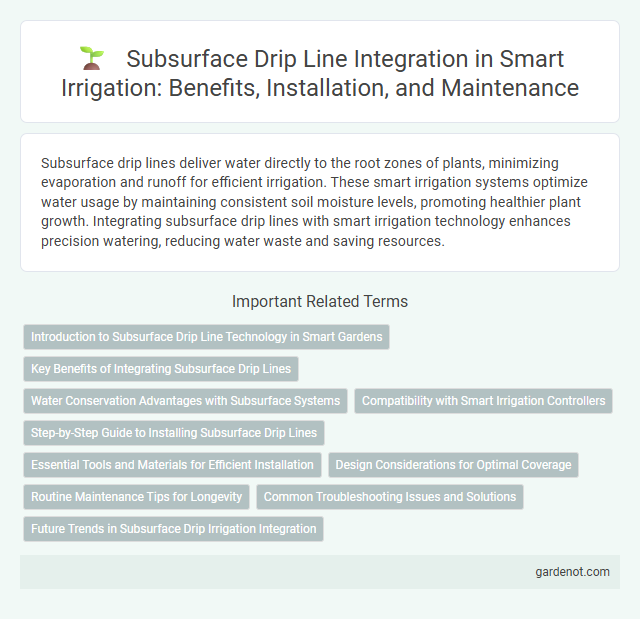Subsurface drip lines deliver water directly to the root zones of plants, minimizing evaporation and runoff for efficient irrigation. These smart irrigation systems optimize water usage by maintaining consistent soil moisture levels, promoting healthier plant growth. Integrating subsurface drip lines with smart irrigation technology enhances precision watering, reducing water waste and saving resources.
Introduction to Subsurface Drip Line Technology in Smart Gardens
Subsurface drip line technology delivers water directly to the root zone of plants through buried porous tubes, enhancing water efficiency in smart gardens. This method reduces evaporation and runoff by applying irrigation beneath the soil surface, optimizing moisture distribution for healthier plant growth. Integration with smart sensors and controllers allows precise scheduling and monitoring, further conserving water resources in sustainable gardening practices.
Key Benefits of Integrating Subsurface Drip Lines
Subsurface drip lines enhance water use efficiency by delivering moisture directly to plant roots, reducing evaporation and runoff. This irrigation method promotes deeper root growth, leading to healthier plants and increased crop yields. Integrating subsurface drip lines also minimizes weed growth and soil erosion, making it a sustainable choice for smart irrigation systems.
Water Conservation Advantages with Subsurface Systems
Subsurface drip line irrigation delivers water directly to the root zone, minimizing surface evaporation and runoff, which significantly enhances water conservation. This targeted delivery reduces water waste by up to 50% compared to traditional surface irrigation methods. In drought-prone regions, subsurface systems optimize water use efficiency, promoting sustainable agriculture and landscape management.
Compatibility with Smart Irrigation Controllers
Subsurface drip line systems are highly compatible with smart irrigation controllers, enabling precise water delivery directly to plant roots while minimizing evaporation and runoff. These systems integrate seamlessly with soil moisture sensors and weather-based controllers to optimize irrigation schedules based on real-time data. Compatibility with smart controllers enhances efficiency, reduces water waste, and supports sustainable landscape management.
Step-by-Step Guide to Installing Subsurface Drip Lines
Installing subsurface drip lines begins with designing an efficient layout based on soil type, crop water needs, and field topography to ensure uniform water distribution. Trenches are then dug to a depth of 6 to 12 inches, where drip tubing with emitters spaced 12 to 24 inches apart is carefully laid to maximize root-zone irrigation. After connecting the tubing to a pressure-regulated water source and flushing the system, backfill the trenches and test the system for leaks and proper flow rates, optimizing water efficiency and promoting healthier plant growth.
Essential Tools and Materials for Efficient Installation
Subsurface drip line installation requires essential tools including a trenching machine for precise pipe placement, pipe cutters for clean cuts, and pressure gauges to monitor system performance. High-quality polyethylene tubing, emitters with appropriate flow rates, and filtration units are critical materials that ensure efficient water distribution and prevent clogging. Proper use of these tools and materials maximizes irrigation efficiency, conserves water, and promotes healthy root growth in agricultural or landscaping applications.
Design Considerations for Optimal Coverage
Subsurface drip line design considerations for smart irrigation emphasize uniform emitter spacing and optimal depth placement to ensure consistent soil moisture distribution and minimize water loss. Selecting appropriate flow rates aligned with soil texture and crop water requirements enhances root zone wetting while preventing surface runoff and evaporation. Proper integration with automated controllers and soil moisture sensors maximizes irrigation efficiency and promotes sustainable water usage.
Routine Maintenance Tips for Longevity
Regularly inspect subsurface drip lines for clogs by flushing the system to prevent emitter blockages caused by soil particles or root intrusion. Monitor water pressure and flow rates to ensure consistent delivery, adjusting filters and pressure regulators as needed to maintain optimal operation. Schedule seasonal checks for wear or damage, replacing any compromised sections promptly to extend the lifespan of the irrigation system.
Common Troubleshooting Issues and Solutions
Common troubleshooting issues with subsurface drip lines include clogging caused by soil particles or mineral deposits, uneven water distribution resulting from line damage or improper installation, and root intrusion blocking emitter outlets. Solutions involve regular flushing of the system, using filtration to prevent particulates from entering the lines, repairing or replacing damaged emitters, and applying root inhibitors or physical barriers to prevent root growth into the drip lines. Proper maintenance and monitoring of pressure levels ensure consistent irrigation performance and extend system lifespan.
Future Trends in Subsurface Drip Irrigation Integration
Future trends in subsurface drip irrigation integration emphasize advanced sensor technology for real-time soil moisture monitoring, enabling precise water delivery and reducing waste. Integration with IoT platforms will facilitate data-driven decision making, optimizing irrigation schedules and enhancing crop yields. Emerging smart materials for drip lines promise increased durability and clog resistance, further improving system efficiency and longevity.
Subsurface drip line Infographic

 gardenot.com
gardenot.com